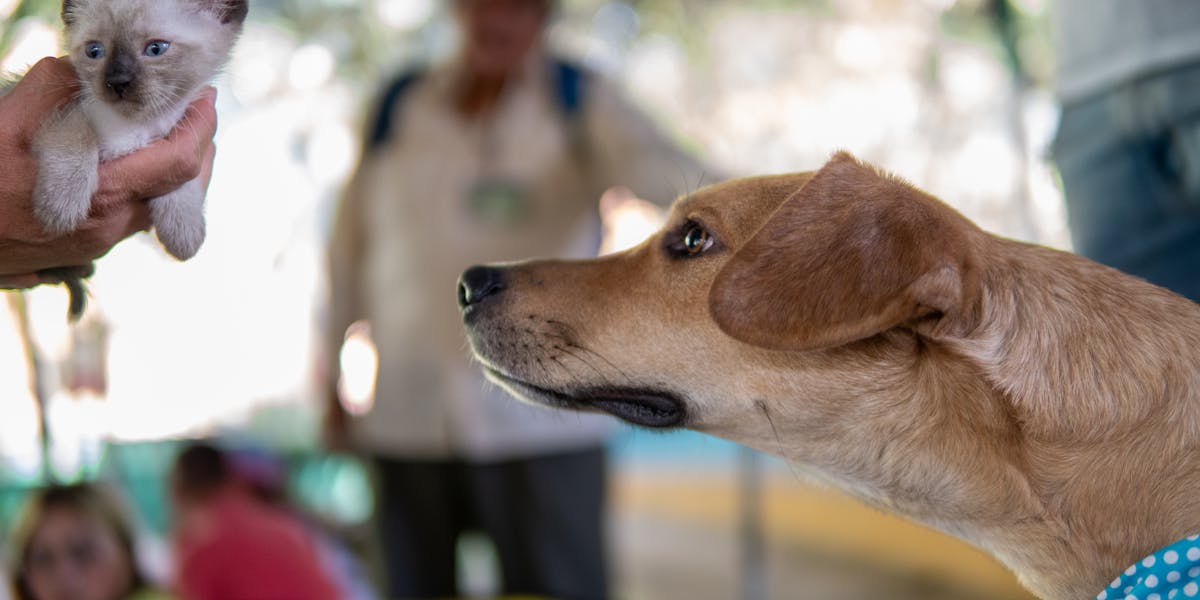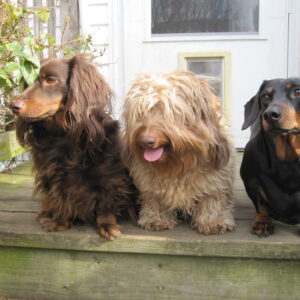Dachshund meeting new pets can be an exciting yet daunting experience for both the dog and its owner. As social creatures, dachshunds have their own unique personalities and behaviors that can influence how they interact with new animals. Understanding these traits is essential for ensuring a harmonious introduction. In this article, we will explore several tips and strategies to help your dachshund navigate new friendships smoothly. From recognizing signs of readiness to fostering positive interactions, we’ll cover everything you need to know to create a comfortable environment for your beloved pet. Get ready to embark on a journey of discovery as we delve into the fascinating world of dachshund introductions!

Tips for a Smooth Dachshund Pet Introduction
Introducing a new pet to your Dachshund can be a rewarding experience. Here are some essential tips to ensure a smooth introduction:
1. Prepare Your Home
Before bringing a new pet home, make sure your space is ready. This includes:
- Removing any items that could be hazardous to your new pet.
- Setting up separate feeding and sleeping areas for both pets.
- Ensuring that your Dachshund has a quiet space to retreat to if needed.
2. Gradual Introductions
Start with brief meetings in a neutral area. This helps both pets feel comfortable. Gradually increase their time together as they become more familiar.
3. Use Positive Reinforcement
Reward your Dachshund with treats and praise when they exhibit calm behavior around the new pet. This creates a positive association with the introduction.
4. Monitor Body Language
Watch for signs of stress or discomfort in both pets. If either pet shows signs of aggression or fear, separate them and try again later.
5. Keep Initial Interactions Short
Limit the first few interactions to just a few minutes. Gradually increase the duration as they become more comfortable with each other.
6. Supervise Playtime
Always supervise playtime between your Dachshund and the new pet. This ensures safety and helps you intervene if necessary.
7. Be Patient
Every pet is unique. Some may take longer to adjust than others. Patience is key to a successful introduction.
By following these tips, you can help create a harmonious environment for your Dachshund and new pet, making the transition smoother for everyone involved.

“`html
Understanding Dachshund Behavior Around New Pets
When introducing a Dachshund to new pets, it’s essential to understand their unique behavior. Dachshunds are known for their strong personalities and instincts. Here are some key behaviors to observe:
- Curiosity: Dachshunds are naturally curious. They may sniff and explore new pets thoroughly.
- Protectiveness: They can be protective of their territory and family. This may lead to barking or growling at new animals.
- Socialization: Early socialization is crucial. A well-socialized Dachshund is more likely to accept new pets.
- Playfulness: Many Dachshunds enjoy playtime. They may initiate play with new pets, showing they are comfortable.
- Body Language: Pay attention to their body language. A wagging tail and relaxed posture often indicate a positive attitude.
Understanding these behaviors can help you create a positive environment for your Dachshund and new pets. Always monitor their interactions and be patient as they adjust to each other.
Remember, every Dachshund is unique, and their reactions can vary. With time and care, they can learn to coexist happily with new companions.
“`
Setting the Stage for Your Dachshund’s First Encounter
Preparing for your Dachshund’s first encounter with a new pet is crucial for ensuring a positive experience. Here are some steps to help you set the stage:
- Choose a Neutral Location: Select a space that is unfamiliar to both pets. This can help reduce territorial behavior.
- Keep It Calm: Ensure that the environment is quiet and free from distractions. A calm atmosphere helps both pets feel more at ease.
- Use a Leash: Keep your Dachshund on a leash during the initial introduction. This allows you to control the situation if needed.
- Introduce Slowly: Allow the pets to see each other from a distance before bringing them closer. This gradual approach can reduce anxiety.
- Observe Body Language: Pay attention to both pets’ body language. Look for signs of stress or discomfort, such as growling or cowering.
By taking these steps, you can create a positive environment for your Dachshund’s first encounter with a new pet. Remember, patience and observation are key to ensuring a smooth introduction.

Signs Your Dachshund is Ready for a New Friend
Introducing a new pet to your household can be a big step, especially for your dachshund. Here are some key signs that indicate your dachshund may be ready for a new friend:
- Increased Curiosity: If your dachshund shows interest in other animals during walks or at the park, it may be a sign they are ready for a companion.
- Playfulness: A noticeable increase in playful behavior, such as bringing toys to you or initiating playtime, can indicate they are seeking a friend.
- Socialization Skills: If your dachshund has been successfully socialized with other dogs and exhibits friendly behavior, they may be prepared for a new pet.
- Calmness Around Other Pets: If your dachshund remains calm and relaxed around other animals, it’s a good sign they are open to making new friends.
- Seeking Attention: When your dachshund actively seeks out your attention and seems to want more interaction, they might be ready to share that attention with another pet.
- Less Territorial Behavior: If your dachshund is less protective of their space and belongings, it could indicate they are ready to welcome a new friend.
Observing these signs can help you determine if your dachshund is ready for a new furry companion. Always ensure that the introduction process is handled carefully to promote a positive relationship.

“`html
Encouraging Positive Interactions Between Pets
Creating a harmonious environment for your pets is essential for their well-being. Positive interactions can lead to lasting friendships and reduce stress for everyone involved. Here are some effective strategies to encourage these interactions:
- Supervised Introductions: Always supervise the first few meetings between your pets. This helps prevent any negative encounters and allows you to intervene if necessary.
- Controlled Environment: Start in a neutral space where neither pet feels territorial. This can help ease tension and promote friendly behavior.
- Positive Reinforcement: Use treats and praise to reward good behavior during interactions. This encourages your pets to associate each other with positive experiences.
- Gradual Exposure: Allow pets to see and smell each other from a distance before full introductions. Gradually decrease the distance as they become more comfortable.
- Playtime Together: Engage both pets in a fun activity, like playing with toys. Shared playtime can help them bond and build trust.
- Respect Individual Personalities: Understand that each pet has a unique personality. Some may take longer to adjust than others, so be patient and attentive to their needs.
By implementing these strategies, you can foster positive interactions between your pets, leading to a happier and more peaceful home.
“`
Common Challenges When Introducing a Dachshund to New Pets
Introducing a Dachshund to new pets can be a rewarding experience, but it also comes with its share of challenges. Understanding these challenges can help you prepare for a smoother introduction.
-
1. Territorial Behavior
Dachshunds are known for their territorial instincts. They may feel threatened by a new pet entering their space, leading to defensive behavior.
-
2. Socialization Issues
Not all Dachshunds are naturally social. Some may be shy or anxious around new animals, which can hinder positive interactions.
-
3. Size Differences
If the new pet is significantly larger or smaller, it can create imbalance in play. Dachshunds might become overly aggressive or overly submissive.
-
4. Jealousy
Introducing a new pet can trigger feelings of jealousy in your Dachshund, especially if they feel they are losing your attention.
-
5. Communication Barriers
Dachshunds have their own way of communicating. Misunderstandings can arise if the new pet does not respond to their signals appropriately.
By being aware of these challenges, you can take steps to address them and help your Dachshund adjust to their new companion.

How to Use Treats to Help Your Dachshund Adjust
Using treats can be an effective way to help your Dachshund adjust to new pets and environments. Here are some strategies to make the most out of treat training:
- Choose the Right Treats: Select small, tasty treats that your Dachshund loves. This will motivate them to engage positively.
- Timing is Key: Offer treats immediately after your Dachshund exhibits calm or friendly behavior. This reinforces good actions.
- Use Treats for Desensitization: If your Dachshund is anxious, give treats while gradually exposing them to the new pet. This creates a positive association.
- Practice Basic Commands: Use treats to encourage basic commands like “sit” or “stay.” This helps establish a sense of control and trust.
- Reward Calm Behavior: Whenever your Dachshund remains calm during interactions, reward them. This teaches them that being relaxed is a good thing.
- Incorporate Treats in Playtime: Use treats as part of playtime to create a fun and positive atmosphere. This can help ease any tension.
By strategically using treats, you can help your Dachshund feel more comfortable and confident in their interactions with new pets. Remember, patience and consistency are essential for successful adjustment.

Monitoring Playtime Between a Dachshund and New Pets
When introducing a Dachshund to new pets, monitoring their playtime is essential for ensuring a positive experience. Here are some guidelines to help you keep an eye on their interactions:
1. Supervise All Playtime
Always supervise your Dachshund and new pets during playtime. This helps to:
- Prevent any aggressive behavior.
- Ensure that everyone is playing safely.
- Intervene if necessary to redirect their energy.
2. Observe Body Language
Understanding body language is crucial. Look for signs such as:
- Relaxed ears and tail: Indicates comfort.
- Stiff body or growling: May signal discomfort or aggression.
- Play bows: Shows that your Dachshund wants to play.
3. Set Time Limits
To prevent overstimulation, set time limits for play sessions. This can help:
- Keep playtime fun and engaging.
- Reduce the risk of fights or stress.
4. Provide Breaks
Allow your Dachshund and new pets to take breaks. This is important because:
- It helps them recharge.
- It prevents them from becoming overly excited or agitated.
5. Use Positive Reinforcement
Encourage good behavior by using positive reinforcement. You can:
- Offer treats when they play nicely together.
- Give praise for calm interactions.
6. Monitor Play Styles
Different pets have different play styles. Keep an eye on:
- How your Dachshund interacts with each new pet.
- Whether play is balanced or if one pet is dominating the other.
7. Know When to Intervene
If you notice any signs of stress or aggression, don’t hesitate to intervene. This might include:
- Separating the pets temporarily.
- Redirecting their attention to toys or other activities.
By closely monitoring playtime between your Dachshund and new pets, you can create a harmonious environment that fosters friendship and fun.

Creating a Safe Space for Your Dachshund and New Animals
Creating a safe environment for your Dachshund and any new animals is crucial for a smooth transition. A well-prepared space can help alleviate stress and promote positive interactions. Here are some key points to consider:
- Designated Area: Set up a specific area in your home where your Dachshund can retreat when feeling overwhelmed. This could be a cozy bed or a quiet corner.
- Safe Boundaries: Use baby gates or barriers to create boundaries. This allows your Dachshund to feel secure while still observing new pets from a distance.
- Familiar Items: Place familiar toys and blankets in the safe space. This can help your Dachshund feel more at ease in the presence of new animals.
- Controlled Introduction: Introduce new pets gradually. Allow your Dachshund to explore the new space while keeping new animals at a safe distance initially.
- Calm Environment: Maintain a calm atmosphere during introductions. Soft music or white noise can help soothe both your Dachshund and new pets.
- Monitoring Interactions: Always supervise initial interactions between your Dachshund and new animals. This ensures safety and helps you intervene if necessary.
By taking these steps, you can create a safe and welcoming environment for your Dachshund and any new companions. This will not only help your pets feel secure but also foster a positive relationship between them.

“`html
Celebrating Successful Meetings: Signs Your Dachshund is Happy
When introducing your dachshund to new pets, it’s essential to recognize the signs that indicate your furry friend is happy and comfortable. Here are some key indicators to celebrate:
- Relaxed Body Language: A happy dachshund will have a relaxed posture, with their tail wagging gently and ears in a natural position.
- Playful Behavior: If your dachshund engages in playful antics, such as bowing or play-barking, it’s a great sign they feel joyful.
- Curiosity: A dachshund that is curious about their new friend, sniffing and exploring, is showing signs of happiness and interest.
- Positive Vocalizations: Happy dachshunds may bark in a friendly manner or make soft whines, indicating excitement.
- Seeking Affection: If your dachshund approaches for pets or cuddles, it’s a clear sign they feel secure and happy in the situation.
- Sharing Toys: If your dachshund offers their toys to the new pet, it shows they are comfortable and willing to share their space.
Recognizing these signs can help you ensure that your dachshund is enjoying their new friendships. Celebrate these moments and continue to foster a positive environment for your pets!
“`




